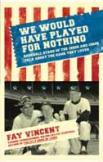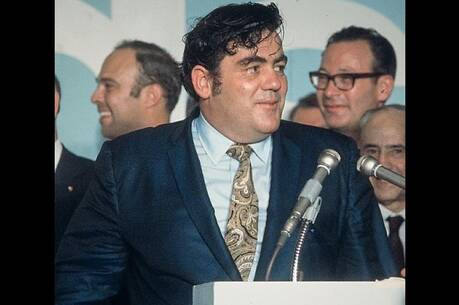Glory Days
At a time when baseball fans are dealing with disappointment and disillusionment in the face of the steroid scandals, 11 star players from the 1950s and 1960s find a voice in Fay Vincent’s latest venture into oral history. Listening to them tell, in their own words, what it was like to play in those days is like looking back on a time of lost innocence. It puts in perspective many of the fascinating changes that baseball has undergone in the last 50 years.
In one sense, the game has never changed. Young men trying to make a name for themselves have always had to master the same basic skills—throwing, catching, hitting and running. The first great change of the modern era came in the 1920s, when home runs multiplied and scoring in bunches replaced the old station-to-station approach—a trend that continued for decades. Duke Snider, Harmon Killebrew and Frank Robinson tell what it was like to compete in the era defined by Aaron, Mantle, Maris and Mays. Since the last years of the 20th century, pitching strategy has undergone a basic alteration. Starters now take the mound every five days instead of four and expect to turn the ball over after six or seven innings to a highly specialized corps of relievers. Robin Roberts, Carl Erskine, Whitey Ford and Lew Burdette take us back to a time when they hoped to go nine innings every four days, shared bullpen duties and hoped to win 20 or more games a year.
Was it a better game than the one we have now? The answer is not simple. Many of today’s players are bigger and stronger. They come to spring training already in shape. They wipe out one record after another. They play to bigger crowds, make many times more money and set some standards of achievement that most of the men of the mid-century could not match. Unfortunately, many of these accomplishments have been tainted by the steroids scandal, which left the public with good reason to wonder how much is to be admired and how much is phony.
Of course, the juiced-up generation did not invent cheating. The Black Sox scandal and Pete Rose’s illicit gambling were bad enough. And in this volume Ralph Branca relates, in fascinating detail, how Bobby Thomson’s famed home run in the 1951 playoffs was made possible by stealing catchers’ signals, not in the accepted way of looking for giveaway movements but by setting up a telescope in the Polo Grounds center field clubhouse. So the Patriots didn’t invent Spygate, after all. And the “Little Miracle of Coogan’s Bluff” wasn’t a miracle, either, but an act of thievery. But there is an important difference between those acts of dishonesty and the present scandal. They were isolated instances. The use of performance-enhancing drugs, on the other hand, was so pervasive that decades of records and statistics are rendered suspect in a way that never touched the players of the 50s and 60s.
There was, however, one dishonorable aspect of the game in those days. The men in this book were victims of real social injustice. Those were the last years before the advent of free agency. Younger readers may be surprised to learn that these great stars and their teammates were locked into an unfair system determined by the infamous reserve clause. Salaries were decided unilaterally by the owners, and players had but two choices: accept the terms offered, or find another way to earn a living. Listening to these men recount how they were repeatedly bullied into accepting terms far below what they deserved makes the title of this book seem more than a bit of hyperbole. And it is the reason Vincent dedicated the book to Marvin Miller, the man who made free agency possible.
All this may sound a bit grim, but don’t expect much negativity from the reminiscences that make up this book. As with his earlier volume of oral history (The Only Game in Town) the author again has chosen a group of truly admirable men who achieved great things in their chosen sport. They took pride in what they did, and deservedly so. Over and over again they look back on such distinctions as being elected to the Hall of Fame and say they got there not just through talent but by dedication and hard work.
Listening to them relive their active years, one is struck by the way they speak about the men who played with and against them. Warm personal relationships shine through their descriptions of those they encountered on the field and in the clubhouse. They really loved the game; they saw in it more than just a path to fame and fortune. When they look at the way so many of today’s players seem like instant millionaires, and remember how they themselves had to find off-season jobs in order to make ends meet, you would expect them to be resentful, if not bitter. But there is not much envy in these pages, only a sense of satisfaction and genuine gratitude for the game they loved.
So how good were the good old days? The crowds were smaller, the salaries lower, and many of the records have long since been surpassed. But there was a sense of integrity that is hard to come by today. That won’t cut down on the attendance and the excitement, but readers of this book may well feel a bit of nostalgia.
This article also appeared in print, under the headline “Glory Days,” in the May 26, 2008, issue.








